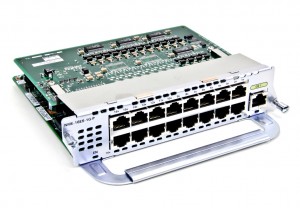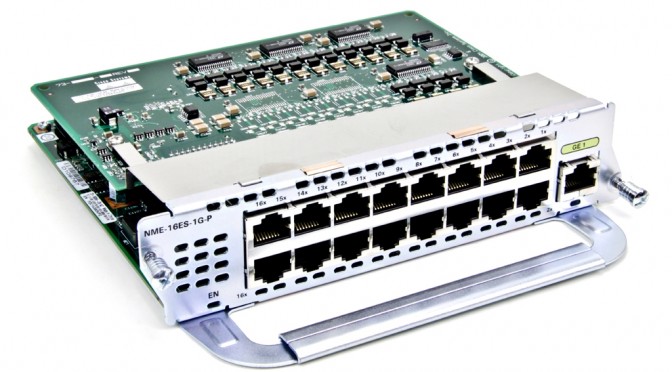 In this tutorial you will learn how to recover from a corrupt or missing Cisco IOS (Internetwork Operating System) at a Cisco EtherSwitch Service Module – switch – 16 ports (NME-16ES-1G-P). The service module IOS runs independent from the host router IOS. After performing this tutorial, the switch service module is running its own IOS again. Alternatively you can use this tutorial to learn how to copy any file from a computer to the host router and/or switch service module. In this case, just ignore the word IOS when we are talking about transferring a file.
In this tutorial you will learn how to recover from a corrupt or missing Cisco IOS (Internetwork Operating System) at a Cisco EtherSwitch Service Module – switch – 16 ports (NME-16ES-1G-P). The service module IOS runs independent from the host router IOS. After performing this tutorial, the switch service module is running its own IOS again. Alternatively you can use this tutorial to learn how to copy any file from a computer to the host router and/or switch service module. In this case, just ignore the word IOS when we are talking about transferring a file.
To recover the IOS, you need at least:
- Terminal console cable
- Ethernet UTP cable
- IOS image file for the service module
- A computer with a TFTP-server, Telnet client (Putty), Network interface card (NIC) and a serial connection (RS-232) for the console cable.
The tutorial consists of three steps:
- Copy (IOS-)file from computer to (host) router
- Set up switch service module so it can receive the (IOS-)file
- Setup host router so it will send the (IOS-)file to the switch service module
Copy (IOS-)file from computer to (host) router
- Connect ethernet cable between NIC of computer and FE0/1 of host router
- Configure NIC of computer:
IP Address: 192.168.0.2
Mask: 255.255.255.0
- Connect desktop serial port (RS-232) with console of host router using the console cable.
- Connect with the host router using a telnet client at the computer such as Putty. Use these serial port settings:
speed 9600 baud
8 data bits
1 stop bit
parity: none
flow control: XON/XOFF
- Configure host router IP-address. Type these commands at the console of the router:
enable configure terminal int fa0/1 ip address 192.168.0.1 255.255.255.0 no shutdown exit ip tftp source-interface fa0/1 exit
- Start TFTP-server at computer. Make sure it is serving the directory which contains the IOS-file.
- Copy file from computer to flash-memory of router. Type this command at the console of the router:
copy tftp://192.168.0.2/ios_file.bin flash:
- Wait a moment while transferring the file from the computer to the flash-memory of the host router.
- After this step, the (IOS-)file for the switch service module is available at the flash-memory of the host router.
Set up switch service module so it can receive the (IOS-)file
- Login to switch service module from the console of the host router:
service-module gigabitEthernet 1/0 session
- Set line speed at the service module:
set BAUD 38400
- Leave service module by pressing these three keys:
CTRL+SHIFT+6at the same time and after that, press:x - Set line speed on host router by executing these commands at the console of the router:
configure terminal line 66 speed 38400 exit exit
Hint: Read section ‘Find line number of switch service module‘ of this tutorial, to know which line number to use.
- Resume connection to service module by pressing two times:
ENTER
ENTER
- Make speed setting persistent on service module by typing this command:
set_param
- Start transfer of (IOS-)file from host router to service module by executing this command at the service module:
copy xmodem: flash:/ios_file.bin
- Now the service module is in a waiting state, waiting for the file which will be received using the XModem-protocol. We will start the XModem-transfer from the host router.
- Exit service module by pressing these three keys together again:
CTRL+SHIFT+6after that, press:x, now type:disconnect
at the console of the host router, which makes the terminal line between host router and service module available for the XModem-transfer.
Setup router so it will send the (IOS-)file
- Start the XModem-transfer from the host router by issuing this command:
copy flash:/ios_file.bin xmodem:
Check/confirm all steps and wait for the transfer.
After this step, the (IOS-)file has been transferred to the flash-memory of the switch service module. Make sure it has the correct/expected IOS-filename. Just power-off / power-on the host router and wait till both the host router and switch service module are ‘up’ again.
Congratulations your switch service module has been recovered from a missing Cisco IOS!
Find line number of switch service module
When setting the line speed between the host router and the switch service module, you need to find the line number at the host router. Type this command at the console of the host router, while in enable-mode:
show line
The output will be something like this:
Tty Line Typ Tx/Rx .......... * 0 0 CTY - ....... 1 1 AUX 9600/9600 ....... * 66 66 TTY 9600/9600 ....... 322 322 VTY - ....... 323 323 VTY - ....... 324 324 VTY - ....... 325 325 VTY - ....... 326 326 VTY - .......
Find here the line where ‘Typ‘ is: ‘TTY‘, the value in the column ‘Tty‘ is the line number.
